Wilderness Medicine is easily the most unique rotation I’ve done in medical school. Run by the Department of Emergency Medicine, Wilderness Medicine teaches students how to provide quality medical care in outdoor settings with limited resources, while also offering immersive experiences in backpacking, rock climbing, caving, and more! Join me as I take you through my past month on this interesting and exciting rotation.

Camping at Pictured Rocks.
In the first week, we jumped right in with outdoor activities and lectures, interactive patient cases that may arise in the wild, a mass casualty simulation event, and orienteering. We learn by listening, but also by doing. Class is fun, engaging, and interactive.
The next week, we backpacked through Pictured Rocks in northern Michigan. The week was filled with beautiful experiences in nature, long hikes, daily “fireside chats” where students educate the group on a topic of their choosing, swimming in Lake Superior, learning to obtain and filter water in the wild, and, of course, camping at a new site each day. By the end of the week, we had developed a strong sense of comradery and accomplishment having backpacked 43 miles together through hot weather at first, then cold and rainy weather, all while fighting off blisters and mosquitos. Despite the struggles at times, the beauty of the nature around us, the freedom of being “unplugged” from phones and social media, and the independence of traveling by foot with all of our food, shelter, and supplies contained in backpacks provided a spectacular and unforgettable experience.
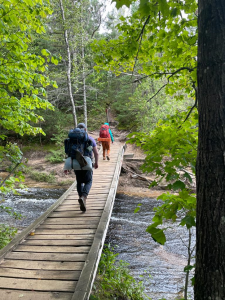
Backpacking at Pictured Rocks.
We had less than a week before our next trip, but in that time we managed to squeeze in kayaking, attending regional wilderness medicine rounds, mountain biking, and daily lectures.
Our next trip, and frankly my favorite part of the course, included rock climbing in Kentucky and caving in Indiana. I, along with several of my classmates, had never done either of these activities before, but we soon learned that we were to be led by experts and could make remarkable progress with no prior experience necessary!
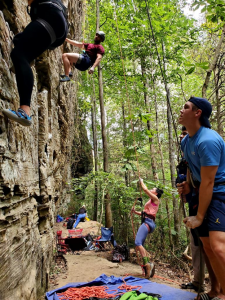
Climbing and belaying at the Red River Gorge.
We rock climbed in the Red River Gorge in Kentucky, a beautiful spot with thousands of natural rock walls of various heights and difficulty levels. It was great trying out the different climbs and watching our experienced resident leaders – Matt and Carlos – climb the more difficult rock walls. It was especially inspiring to see classmates who had a fear of heights overcome these fears and ascend multiple climbs! Climbing by day, we spent the evenings camping at Miguel’s and eating dinner at local spots in the small town of Slate, Kentucky.
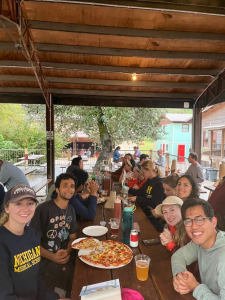
Dinner at Miguel’s.
After two eventful days of climbing, we drove up to Buckner Cave in Indiana. Here, we learned about and experienced exploring a “wild cave,” led by expert cavers Anmar and Jess. At times, the cave was barely a foot and a half tall, necessitating belly crawling or rolling to move forward. In other spots, we climbed up or down narrow passages, navigated around obstacles, or, rarely, were able to walk through open spaces.
We learned tricks to avoiding hypothermia in caves (hint: it involves a contractor bag and a candle!), medical considerations for evacuating patients from caves, and basic geology on how and why caves form. We also had a moment where everyone turned off their headlamps and sat perfectly still so we could meditate in the pitch-black darkness and perfect silence that is unique to caves. We debriefed and celebrated this unique experience with smores and hot dogs around the campfire on our last night camping together as a group.
The following day, having explored the cave once, we did a simulated evacuation of a “patient” (one of our classmates) from the cave. It required extensive teamwork and coordination, but we managed to carry our classmate out on a “litter” (similar to a stretcher) through all of the obstacles and tight spaces of the cave to safety.
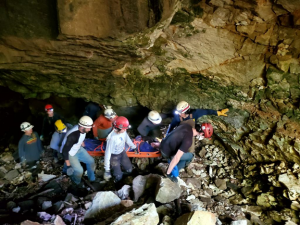
Extricating our “patient” from the cave.
After a team lunch, we drove back to Ann Arbor where we would finish up the course with a series of evidence-based medicine talks and a final exam of both written questions and scenario-based stations. Each student gave a talk on a wilderness medicine topic of their choosing, from managing obstetric emergencies in the wilderness to things that can go wrong while scuba diving or summiting mountains to the efficacy and importance of bug spray and sunscreen in the wild. We learned from each other, as we had throughout the course, both inside and outside of the classroom.
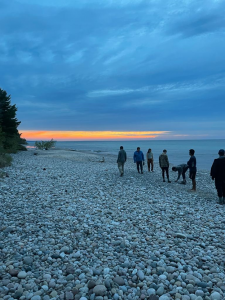
Sunset on Lake Superior.
As I reflect on the past month, I am in awe of how many new and unique experiences I have had in such a short span of time, as well as by the wealth of knowledge I have acquired on such a wide variety of wilderness medicine topics. Watching the sunset on Lake Superior, camping under the stars, scaling large rock walls in Kentucky, and exploring a cave 80 feet underground in Indiana were experiences my classmates and I will never forget. I wholeheartedly recommend this course for any student or prospective student whether or not they plan to pursue a career in wilderness medicine. I am so grateful for the amazing opportunity this course provided, as well as for the incredible resident and faculty leaders that made it happen.
Don’t miss the next Dose of Reality.
Maya Hammoud is a fourth-year medical student at the University of Michigan. She is pursuing a career in general surgery, with an emphasis on medical education, clinical outcomes research, and improving diversity, equity, and inclusion in healthcare. In her free time she enjoys gymnastics, swimming, hiking, and reading.
